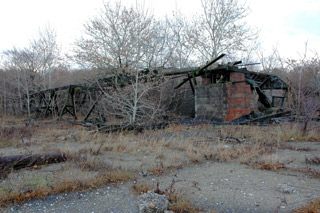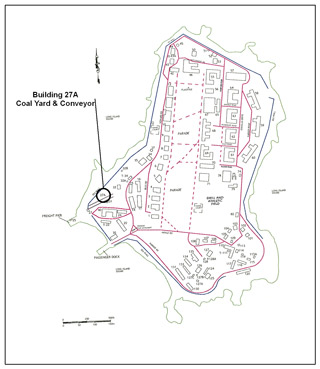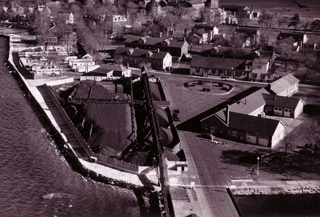|

DATE BUILT: 1932-ca. 1939
STYLE: Engineered storage facility (mid-20th century)
PRINCIPAL ALTERATIONS: Wood-frame coal shed demolished ca. 1939 and replaced by the open concrete storage yard and the mechanized distribution system.
OTHER DESIGNATIONS: Identified as Building 118 until 1941 when the Post Engineer designated the Coal Yard as Building 107. It may not have had a numerical designation in Fort Slocum’s final building numbering system, introduced in 1957. The New York District of the Army Corps of Engineers designated the Coal Yard as Building 27A in 2004 during preparation for the cleanup and restoration of former Fort Slocum.

DESCRIPTION: The Coal Yard and Conveyor transferred coal delivered to Davids Island by barge and stored it until it was needed for use around the island.
The Coal Conveyor was nearly 600 feet long, extending from the outer end of the Freight Dock to the far end of the Coal Yard. At the end of the dock, a clamshell bucket and hoist unloaded coal from barges and dumped it on the electrically-powered conveyor belt, which carried it to the Coal Yard. In the yard, a mobile gantry supported by wood trestles transferred the coal from the conveyor and distributed it across the yard.
The Coal Yard occupied an irregular polygon of slightly less than 1 acre. It had a paved concrete surface and was surrounded by a solid, modular concrete wall 8 feet in height. Along the wall were two small buildings. One of these (Building 31) was probably the coal yard office, where the receipt and distribution of coal was managed. The other (Building 27) seems to have been a machine shed or electrical transformer shelter for the conveyor system.
The configuration of the Coal Yard changed several times during the history of Fort Slocum. In its final version, described here, it could store 9,000 tons of coal, an ample supply for the post. The coal was stored outdoors in large piles until needed. Trucks delivered coal from the yard to individual buildings on the post, where it fueled boilers and other heating devices.

HISTORICAL NOTES: The Coal Yard and Conveyor unloaded and stored thousands of tons of coal at Fort Slocum each year. The Army used coal to heat the post’s buildings in winter, and nearly every building had an individual boiler to provide steam heat. Coal also served as fuel for other purposes on the post, such as trash incineration and heating water for the post’s central laundry.
Barges delivered Fort Slocum’s coal to the Freight Pier, originally known as the Coal Dock. The first Coal Dock was constructed in 1878 and originally had a large storage shed on it. The dock was enlarged and altered in 1893.
Beginning in the 1930s equipment at the end of the Freight Pier included a mast, gaff, hoist and bucket for unloading barges, a conveyor system with hopper, and a control shed. The enclosed conveyor carried the coal off the pier to the onshore storage area.
Originally, the conveyor transferred coal to a coal shed on the shore in the Quartermaster Area. Built in 1893 and expanded in 1914, the Coal Shed was a large wood-frame building with an open interior for the storage of coal. The Army demolished the shed in 1938 or 1939 as part of a renovation project. After 1939 the conveyor carried coal to the open Coal Yard.
Until the 1930s mule carts hauled coal from the Coal Yard and delivered it to individual buildings around the post. The Army stopped using mules at Fort Slocum in 1938, and thereafter used motor trucks exclusively.
When the New York District of the U.S. Army Corps of Engineers began its cleanup and restoration project on Davids Island in 2005, evidence of Fort Slocum’s appetite for coal seemed to be everywhere. There were remnants of abandoned coal piles scattered about the island, and archeological testing often encountered coal cinders in the soil.
|







